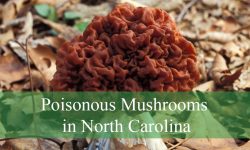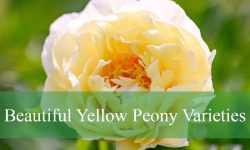As a gardener, I’ve come to realize that weeds with yellow flowers can be both beautiful and troublesome. These vibrant yellow blooms often appear unexpectedly, popping up in our lawns, flower beds, and even in cracks of the pavement. While they might catch your eye, many of these plants can quickly spread and take over, competing with your prized plants for space and nutrients.
Some of these yellow-flowered weeds are quite resilient, thriving in various conditions—from dry, barren patches to lush, moist gardens. Dandelions may be scattered throughout the grass, or goldenrods might be growing tall in your garden’s borders. Learning how to identify these weeds is crucial for keeping your garden in check.
In this article, I’m sharing a list of 40 common weeds with yellow flowers, complete with helpful identification tips and pictures. Whether you’re a gardener, land manager, or simply curious about the yellow blooms popping up in your area, this resource will help you recognize and understand each species more clearly.
Different Types of Weeds with Yellow Flowers
Dandelion (Taraxacum officinale)
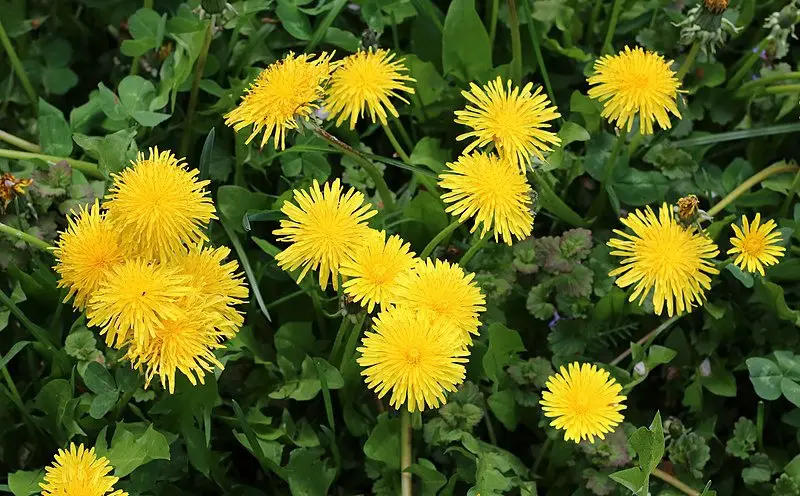
The dandelion is a perennial broadleaf weed recognized by its bright yellow, composite flowers and deeply toothed, hairless leaves that grow in a basal rosette. Each flower head is made up of numerous tiny florets, and the plant produces a single, hollow flower stalk per bloom. Once the flower matures, it transforms into a round, white seed head that disperses seeds with the wind.
This plant is a master of adaptation, able to thrive in compacted soils, disturbed areas, and well-maintained lawns. It begins growing in early spring and can continue to flower throughout the growing season under favorable conditions. Dandelions are known for their strong taproots, which allow them to regrow even after being pulled from the soil.
Dandelions are native to Eurasia but are now widespread across North America. They are found in USDA hardiness zones 3 through 10 and are commonly considered a nuisance in turfgrass, gardens, roadsides, and agricultural fields. Despite their weedy reputation, they are edible and are sometimes used in herbal medicine and culinary dishes.
Yellow Wood Sorrel (Oxalis stricta)
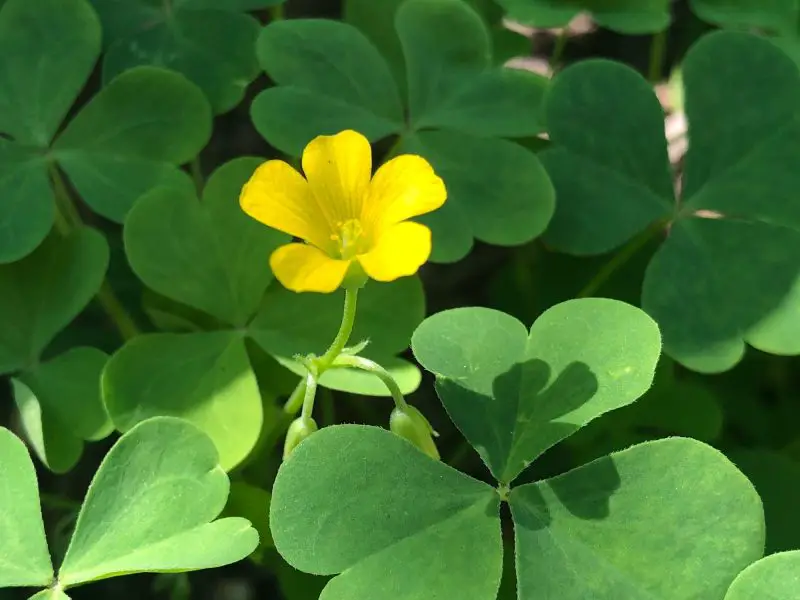
Yellow Wood Sorrel is a small herbaceous plant with clover-like trifoliate leaves and delicate yellow flowers composed of five petals. Each leaf consists of three heart-shaped leaflets, which fold inward at night or when under stress. The stems are slender and often tinged with a reddish hue, and the seed pods are slender, cylindrical capsules.
This weed is a prolific self-seeder and can quickly spread through lawns, flower beds, and cracks in sidewalks. It prefers partial shade to full sun and can tolerate a range of soil conditions, particularly moist, well-drained soils. Oxalis stricta also exhibits nyctinastic movement, closing its leaves and flowers in response to light levels.
Yellow Wood Sorrel is native to North America and is commonly found throughout the United States and southern Canada. It thrives in USDA hardiness zones 4 to 9. Despite its weedy nature, the plant has culinary uses, offering a tangy, lemony flavor due to its oxalic acid content, although it should be consumed in moderation.
Common Ragwort (Jacobaea vulgaris)
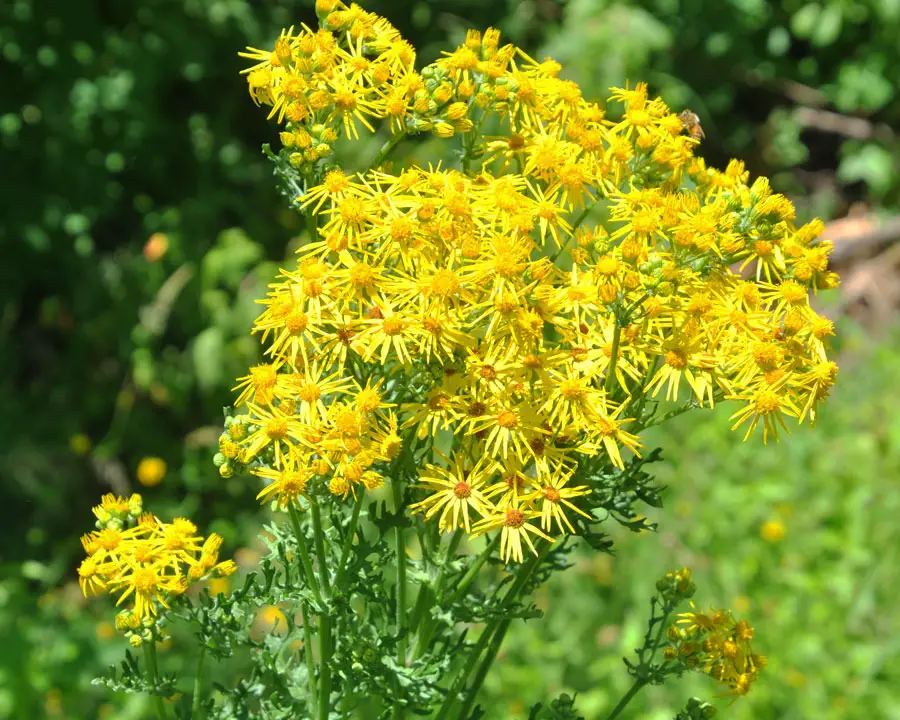
Common Ragwort is a biennial or short-lived perennial plant characterized by clusters of bright yellow, daisy-like flowers with 13 narrow petals each. Its leaves are deeply lobed and alternate along the stem, giving it a feathered appearance. The plant can grow between 1.5 to 3 feet tall and often emits a distinct odor when crushed.
This species begins its life as a low-growing rosette in its first year, developing a tall, flowering stalk in the second year. It typically blooms from June to October, producing copious amounts of seeds that are dispersed by wind. Common Ragwort contains toxic alkaloids that are harmful to livestock, particularly horses and cattle.
Native to Europe and western Asia, Common Ragwort has naturalized in parts of North America, especially in disturbed habitats like roadsides, pastures, and abandoned fields. It grows well in USDA zones 4 to 8 and prefers sunny areas with well-drained soils. Due to its toxicity and aggressive growth, it is often targeted in weed control programs.
Bird’s Foot Trefoil (Lotus corniculatus)
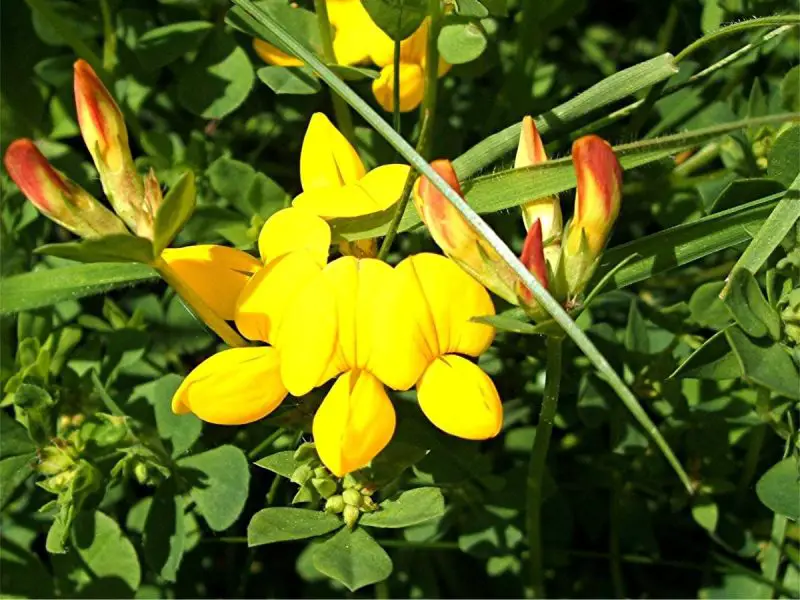
Bird’s Foot Trefoil is a low-growing, spreading legume with slender stems and compound leaves divided into five leaflets. It produces clusters of small, bright yellow, pea-shaped flowers that can sometimes have orange or red streaks. The seed pods resemble a bird’s foot in structure, which is how it gets its common name.
This plant is both drought-tolerant and cold-hardy, making it a successful colonizer of poor soils, roadsides, and pasturelands. It is often used for erosion control and as forage for livestock, although it can become invasive in some regions due to its persistent root system and abundant seed production.
Originally native to Europe and Asia, Bird’s Foot Trefoil has become widespread across North America. It is well-adapted to USDA hardiness zones 3 to 9. Though it offers benefits for pollinators and soil health, its ability to outcompete native flora makes it a concern in some natural habitats.
Butterweed (Packera glabella)
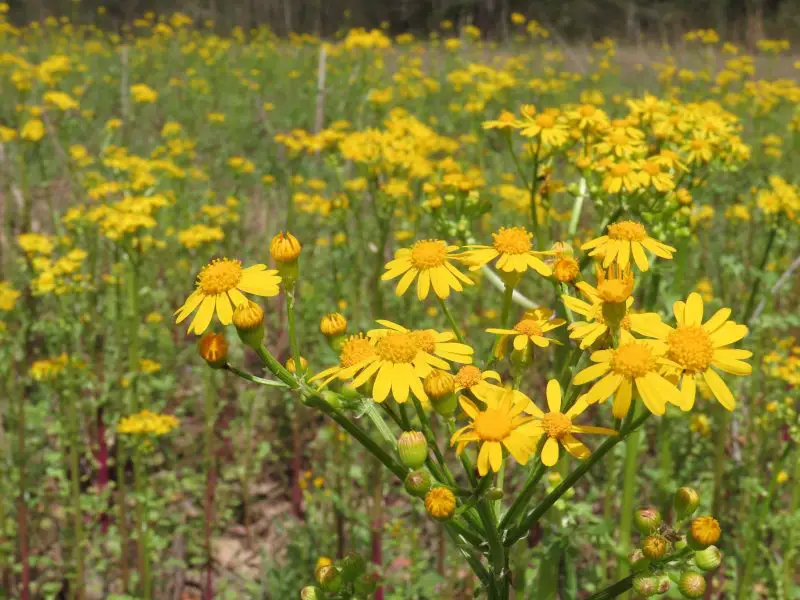
Butterweed is an annual herbaceous plant with erect, hollow stems and bright yellow, daisy-like flower clusters. It can reach heights of 2 to 3 feet and has deeply lobed, bluish-green leaves that clasp the stem. The flowers bloom in early spring, making the plant one of the first weeds to appear in open fields and ditches.
This species thrives in moist, low-lying environments such as floodplains, wet pastures, and along waterways. It reproduces by seed and grows rapidly in nutrient-rich, disturbed soils. Its dense growth can form monocultures, crowding out other plant species and reducing biodiversity in sensitive areas.
Butterweed is native to parts of the southeastern and central United States and has expanded its range northward in recent decades. It is commonly found in USDA zones 5 through 9. While it adds color to spring landscapes, the plant is mildly toxic and should not be grazed by livestock.
Common Groundsel (Senecio vulgaris)
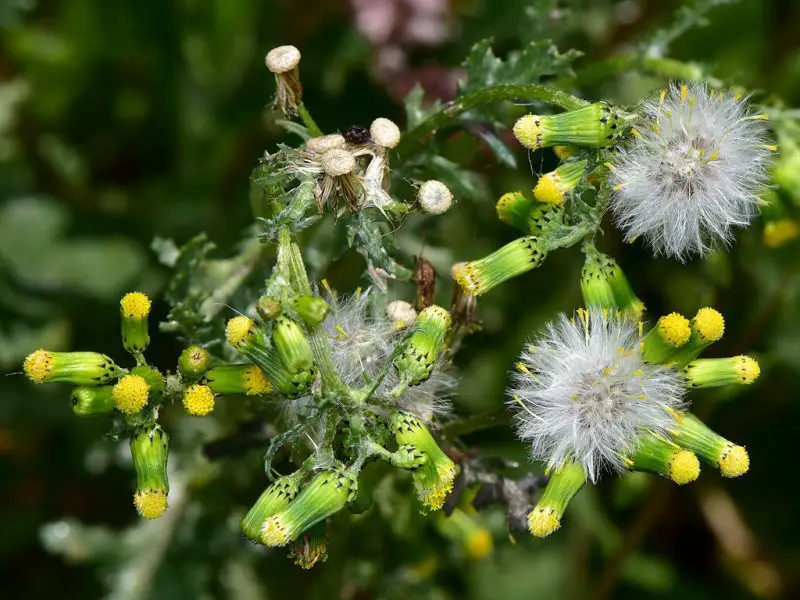
Common Groundsel is a fast-growing annual weed with small, tubular yellow flowers enclosed by green, hair-tipped bracts, giving the flower heads a slightly closed appearance. Its leaves are soft, deeply lobed, and irregularly toothed, often with a slightly fleshy texture. The plant grows upright and typically reaches heights of 6 to 18 inches.
This weed is highly adaptable and reproduces quickly, often completing several generations in a single growing season. It prefers disturbed soils and is commonly found in gardens, roadsides, nurseries, and agricultural areas. The seeds are light and easily dispersed by wind, allowing the plant to spread widely and colonize new areas rapidly.
Native to Europe and parts of Asia, Common Groundsel is now found throughout North America. It thrives in USDA hardiness zones 4 through 10. Though small and unassuming, this plant contains toxic pyrrolizidine alkaloids and can be harmful to livestock if ingested in large quantities.
Goldenrod (Solidago spp.)
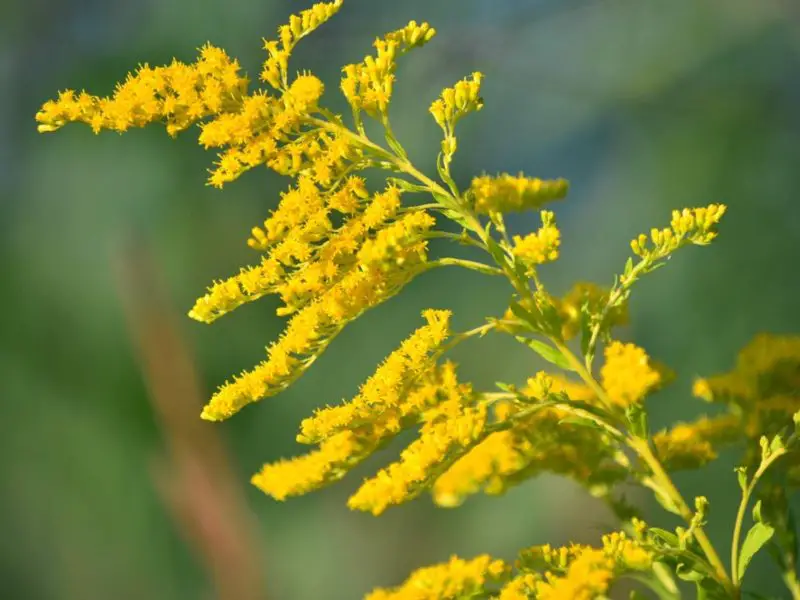
Goldenrod refers to a genus of perennial plants known for their tall, leafy stems and showy, plume-like clusters of tiny yellow flowers. These flower heads bloom late in the growing season, typically from late summer to early fall, and are composed of many small florets that attract bees, butterflies, and other pollinators.
Often mistaken as the cause of hay fever (which is actually due to ragweed), goldenrod thrives in sunny, open areas including meadows, prairies, roadsides, and forest edges. It is drought-tolerant and spreads by rhizomes or seed, depending on the species. The plant forms dense stands and is often used in naturalistic and pollinator gardens.
Goldenrod species are native to North America and are found across a wide range of USDA zones, generally from 3 to 9. While beautiful and ecologically beneficial, some species can be aggressive in garden settings, requiring careful management to prevent unwanted spread.
Creeping Cinquefoil (Potentilla reptans)
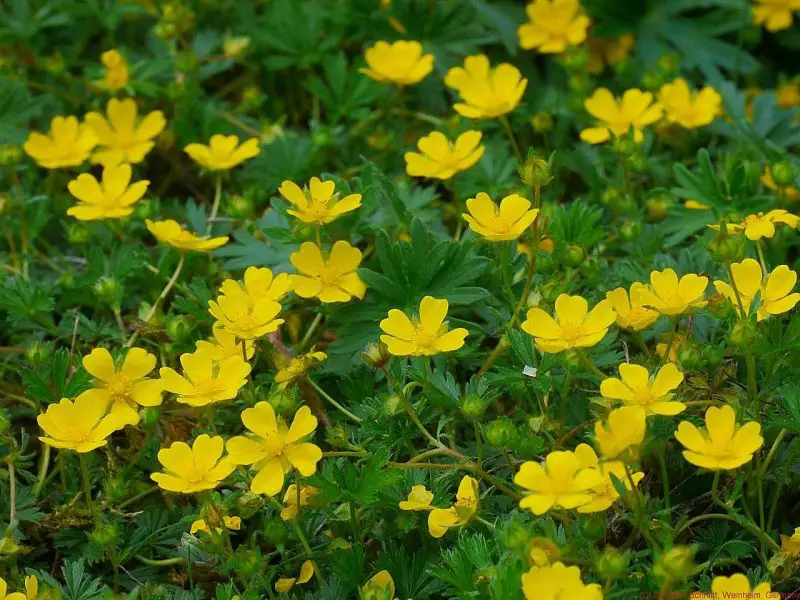
Creeping Cinquefoil is a low-growing, trailing perennial weed with bright yellow flowers that have five rounded petals. Its leaves resemble those of strawberries, with five leaflets arranged in a palm-like pattern. The plant spreads by long, slender stolons that root at the nodes, forming dense mats across the ground.
This weed is most commonly found in lawns, pastures, and disturbed soils, where it thrives in full sun and well-drained conditions. It blooms from late spring through summer, with flowers rising singly on thin stems above the foliage. Its ground-hugging nature helps it avoid mowing and allows it to persist in regularly maintained landscapes.
Native to Europe and western Asia, Creeping Cinquefoil has become widely naturalized in North America. It grows well in USDA zones 4 to 8. Though its small yellow flowers may seem charming, its aggressive spreading habit can quickly make it a nuisance in gardens and turfgrass.
Black Medic (Medicago lupulina)
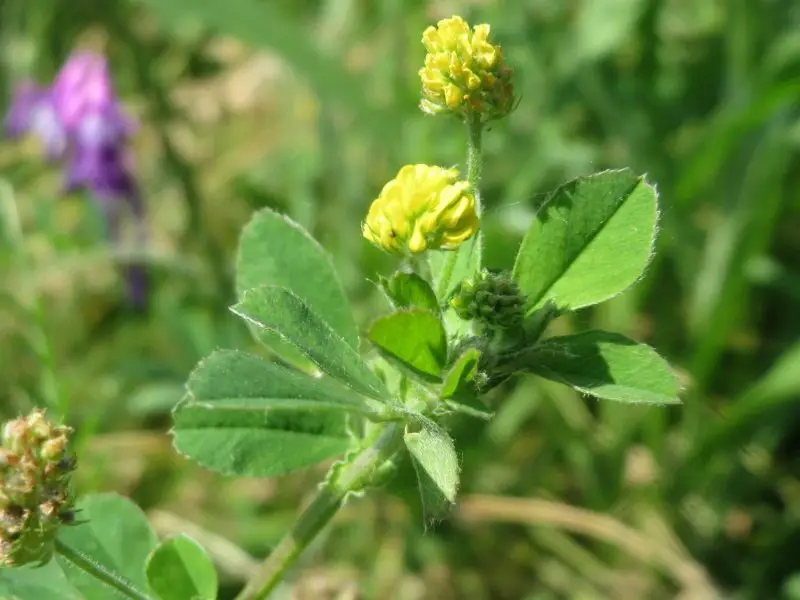
Black Medic is a prostrate or slightly ascending annual or short-lived perennial weed with clover-like trifoliate leaves. It produces tiny, bright yellow, pea-like flowers clustered into small, rounded heads. As the flowers mature, they turn into black, spiraled seed pods, which are a key identifying feature.
This plant favors dry, compacted soils and is frequently seen in lawns, roadsides, vacant lots, and disturbed areas. It often serves as an indicator of low nitrogen levels in soil. Although not especially tall, it forms a spreading mat that can compete with turfgrass and other low-growing plants.
Black Medic is native to Eurasia but is now widespread in North America, particularly in USDA hardiness zones 3 through 9. Despite its weed status, it is part of the legume family and has nitrogen-fixing capabilities, making it beneficial in certain cover crop applications, though not ideal in manicured landscapes.
Yellow Rocket (Barbarea vulgaris)
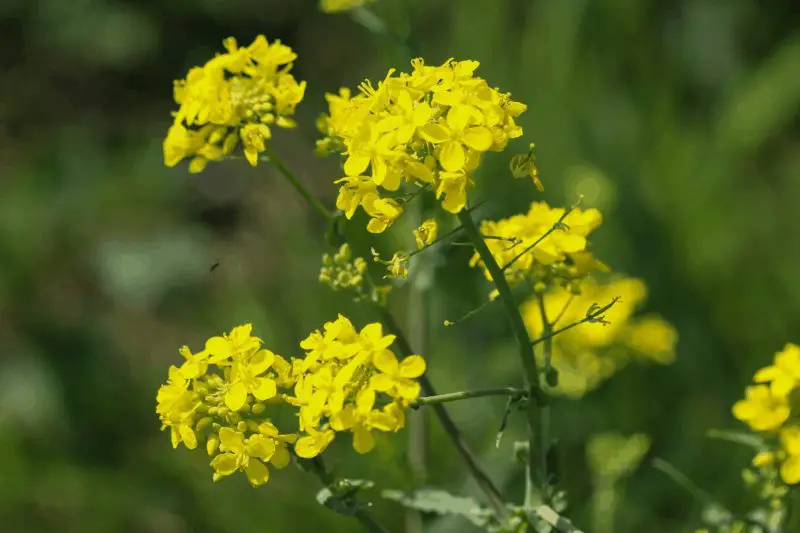
Yellow Rocket, also called Winter Cress, is a biennial plant that starts as a rosette of shiny, dark green leaves in its first year. In its second year, it sends up upright stems topped with clusters of small, four-petaled yellow flowers resembling those of mustard plants. The mature plant can grow up to 2 feet tall or more.
This species favors moist, fertile soils and is typically found in fields, roadsides, gardens, and along riverbanks. It blooms in early to mid-spring, often one of the first wildflowers to appear after winter. Its ability to grow in disturbed sites allows it to spread easily and establish in a variety of environments.
Native to Europe and parts of Asia, Yellow Rocket has become widely naturalized across much of the United States. It is hardy in USDA zones 4 to 8. Although attractive to early pollinators, it is often viewed as a weed due to its rapid colonization and potential to outcompete other vegetation.
Common St. John’s Wort (Hypericum perforatum)
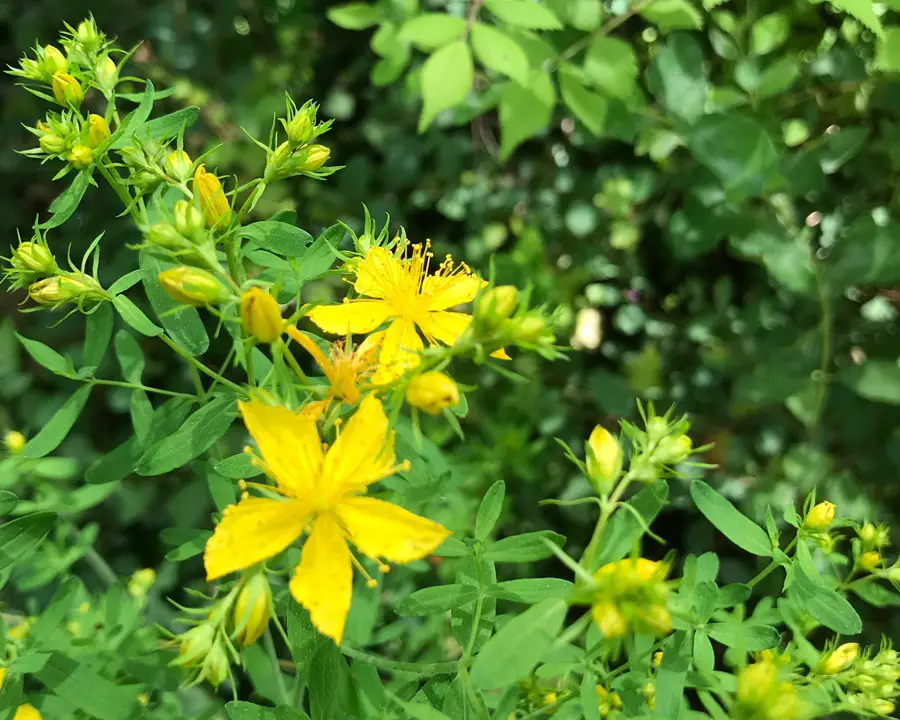
Common St. John’s Wort is a perennial herbaceous plant with vibrant yellow flowers featuring five petals and distinctive black dots along the edges. The leaves are opposite, oval, and covered in tiny translucent dots that appear perforated when held to the light. The plant typically grows 1 to 3 feet tall with a bushy, upright form.
It blooms from late spring through summer and is often found in pastures, meadows, roadsides, and disturbed soils. Known for its medicinal use in herbal remedies, particularly for mild depression, it also poses a risk to grazing animals due to compounds that can cause photosensitivity. The plant spreads both by seed and underground rhizomes.
Native to Europe and Asia, St. John’s Wort is now widespread across North America, especially in USDA hardiness zones 3 to 8. Despite its healing reputation, it is classified as a noxious weed in several regions due to its invasiveness and ability to dominate native plant communities.
Curlycup Gumweed (Grindelia squarrosa)
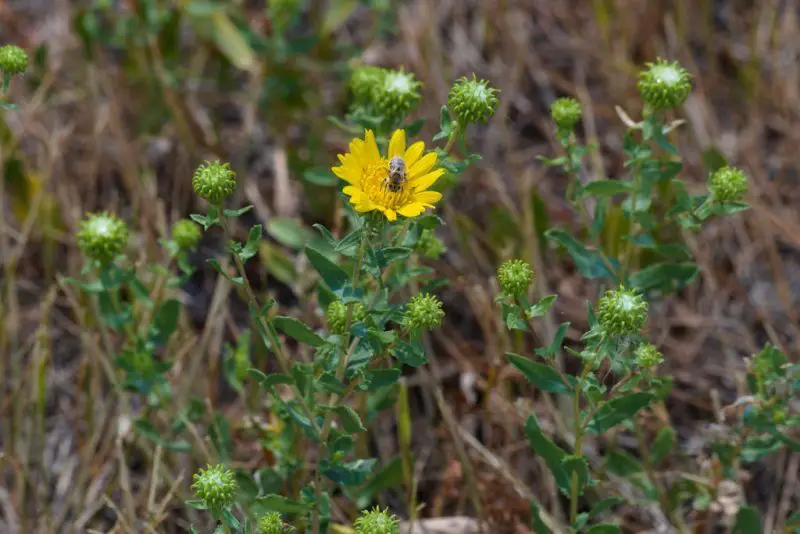
Curlycup Gumweed is a tough, aromatic biennial or short-lived perennial known for its sticky, resin-coated flower heads and spiny-toothed leaves. The bright yellow flowers resemble daisies, blooming singly at the top of thick, branched stems. The buds are encased in green bracts that curl backward—hence the name “curlycup.”
This plant thrives in arid, open habitats such as prairies, roadsides, and rangelands. It is highly drought-tolerant and can grow in poor, rocky soils where few other plants can survive. The resinous coating deters herbivores and protects the plant from water loss.
Native to North America, Curlycup Gumweed grows predominantly in the western and central United States and is hardy in USDA zones 4 to 8. While considered a weed in grazing areas, it has historical medicinal uses and is valued in some traditional practices for treating respiratory issues.
Yellow Toadflax (Linaria vulgaris)
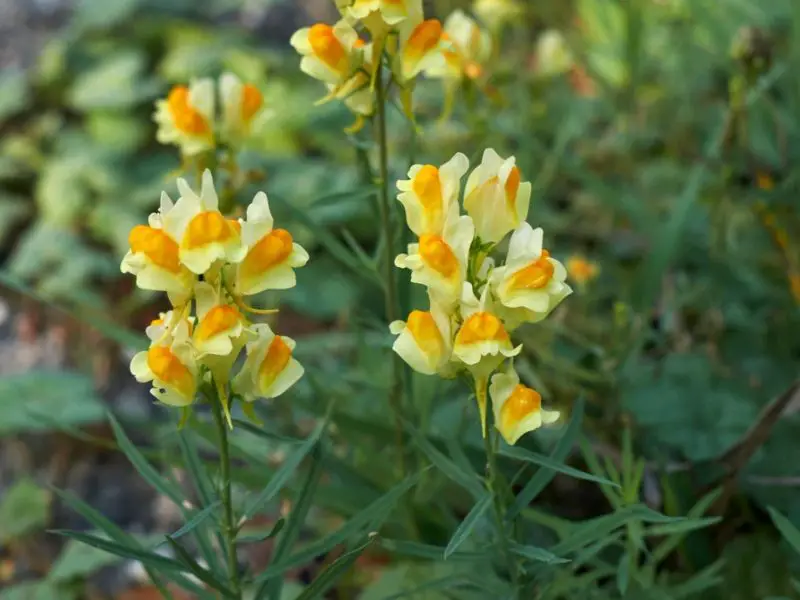
Yellow Toadflax, also called butter-and-eggs, features snapdragon-like yellow flowers with bright orange throats and long spurs. The narrow, bluish-green leaves are arranged alternately on the stem, and the plant grows upright, reaching heights of 1 to 3 feet. Its attractive flowers bloom from late spring into early fall.
Often found in roadsides, grasslands, and abandoned fields, Yellow Toadflax is a vigorous grower that spreads both by seed and creeping rhizomes. Its rapid growth and dense colonies make it highly competitive with native vegetation. The plant is considered invasive in many parts of North America.
Originally native to Europe and Asia, Yellow Toadflax has spread throughout the United States and Canada. It thrives in USDA zones 3 to 9. Despite its ornamental appeal, it is difficult to control once established and is not recommended for cultivation.
Wild Mustard (Sinapis arvensis)
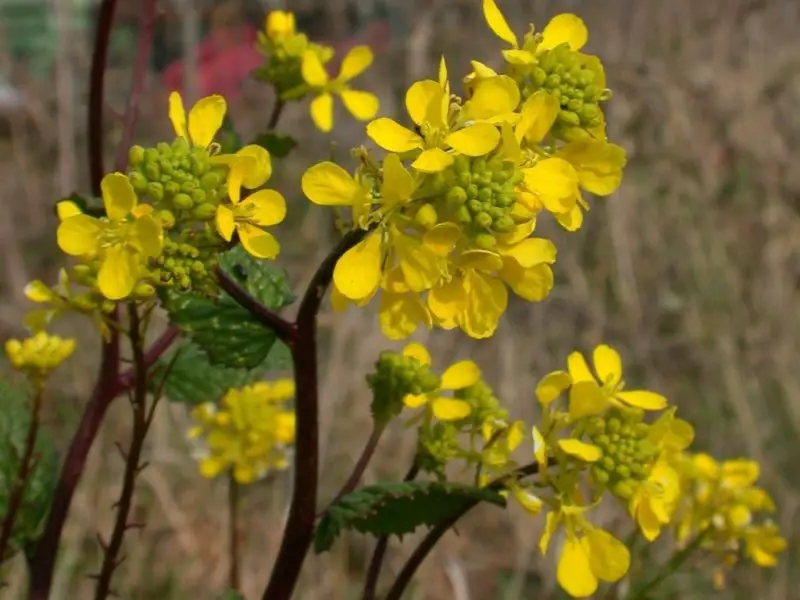
Wild Mustard is an annual or biennial plant with clusters of bright yellow, four-petaled flowers that form at the tips of branched stems. The leaves are rough, deeply lobed, and arranged alternately along the stem. This weed can grow from 1 to 3 feet tall and is easy to recognize by its strong mustard-like odor when crushed.
It is commonly found in fields, gardens, roadsides, and disturbed areas, especially where crops like wheat or barley are grown. Wild Mustard germinates in early spring and can produce dense stands that compete with crops for light, nutrients, and space. The plant reproduces solely by seed, which can remain viable in the soil for many years.
Native to Europe, Wild Mustard is now naturalized throughout North America and grows well in USDA zones 3 through 9. Although some parts of the plant are edible, its invasive nature and tendency to crowd out beneficial plants make it a troublesome weed in many agricultural settings.
Hairy Bittercress (Cardamine hirsuta)

Hairy Bittercress is a small, fast-growing annual or biennial weed with tiny yellow flowers atop slender stems. The leaves are pinnately compound with rounded leaflets forming a basal rosette. It gets its name from the fine hairs that cover its stems and leaf stalks, although they are not always noticeable without close inspection.
The plant is known for its explosive seed dispersal mechanism—when mature seed pods are touched, they burst open and shoot seeds several feet away. It typically emerges in late winter or early spring and is often found in moist garden beds, cracks in pavement, and disturbed soil.
Native to Europe and Asia, Hairy Bittercress is now widespread across North America and thrives in USDA zones 4 to 9. Though small and short-lived, it can quickly colonize areas and become a nuisance in garden settings due to its rapid reproduction and seed-spreading capabilities.
Yellow Sweet Clover (Melilotus officinalis)
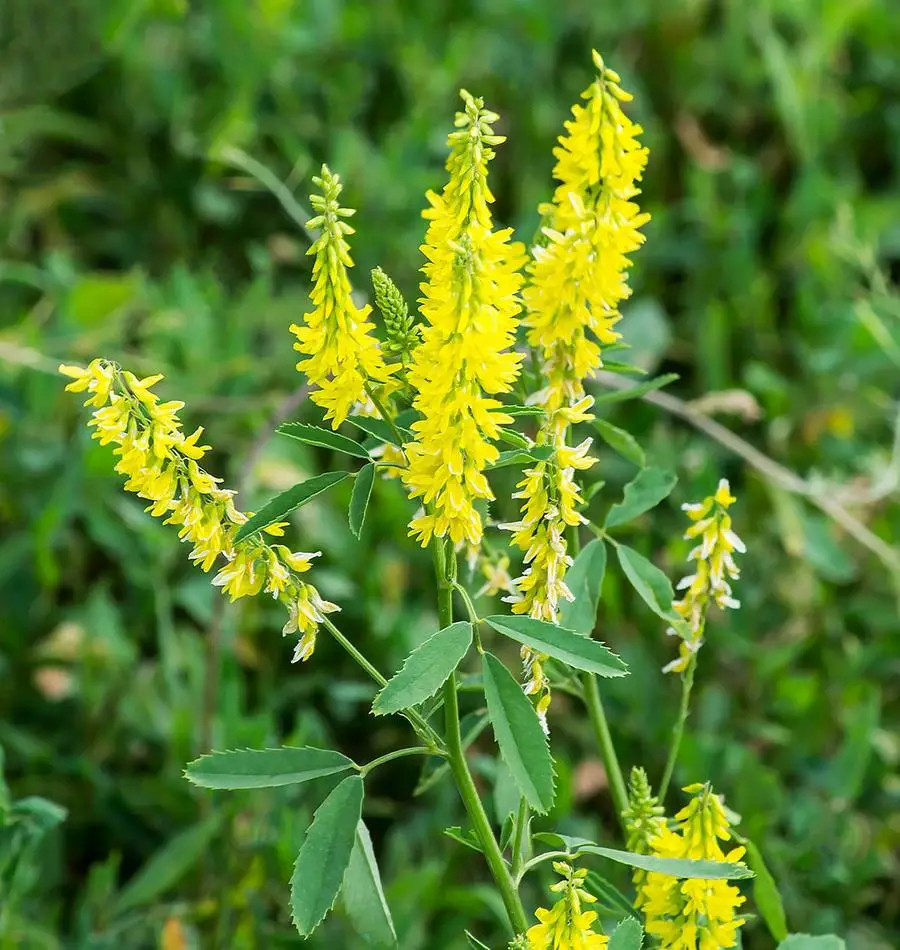
Yellow Sweet Clover is a biennial plant that can grow up to 5 feet tall, with a branching, bushy habit. It features trifoliate leaves resembling those of true clovers and produces slender, elongated clusters of tiny yellow flowers during late spring and summer. The flowers are fragrant and rich in nectar, attracting bees and other pollinators.
It thrives in disturbed areas, fields, roadsides, and waste places. In its second year, it grows vigorously and can become dominant in open habitats. Yellow Sweet Clover has a deep taproot, which allows it to tolerate dry soils, and it improves soil nitrogen through its symbiotic relationship with nitrogen-fixing bacteria.
Native to Europe and Asia, this plant is now widespread across North America, particularly in USDA hardiness zones 3 to 9. While it has some use as forage and green manure, it can be invasive, crowding out native vegetation and altering soil chemistry over time.
Narrowleaf Hawksbeard (Crepis tectorum)
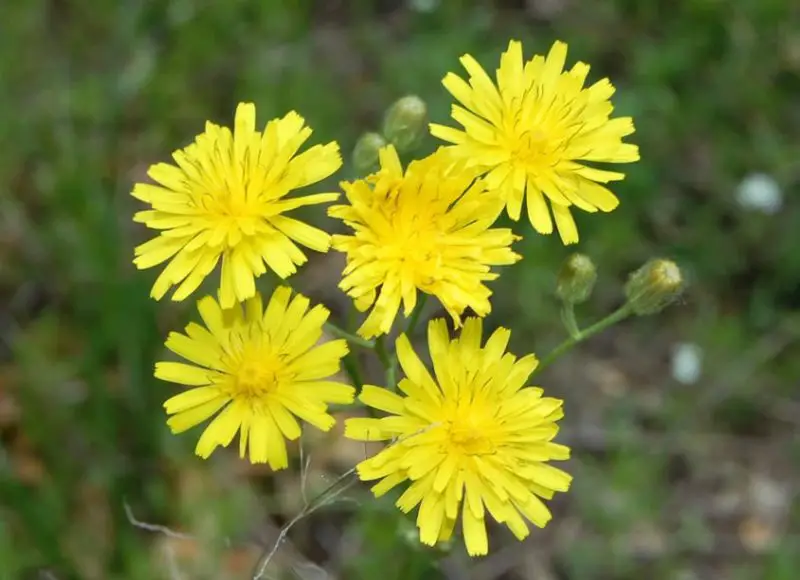
Narrowleaf Hawksbeard is an annual or biennial weed with upright stems and multiple yellow flower heads resembling small dandelions. The narrow, deeply lobed leaves form a basal rosette and continue up the stem in a more linear form. Its flowers bloom in summer, often closing by midday.
This plant is commonly found in dry pastures, roadsides, and disturbed soils, especially in regions with low rainfall. It spreads through wind-dispersed seeds and thrives in full sun and well-drained soils. Though not especially tall—usually between 1 and 3 feet—it often forms dense patches.
Native to Europe and Asia, Narrowleaf Hawksbeard is established throughout parts of North America, particularly in USDA zones 3 to 7. It is considered a competitive weed in crop fields and rangelands due to its rapid growth and prolific seed production.
Goat’s Beard (Tragopogon dubius)
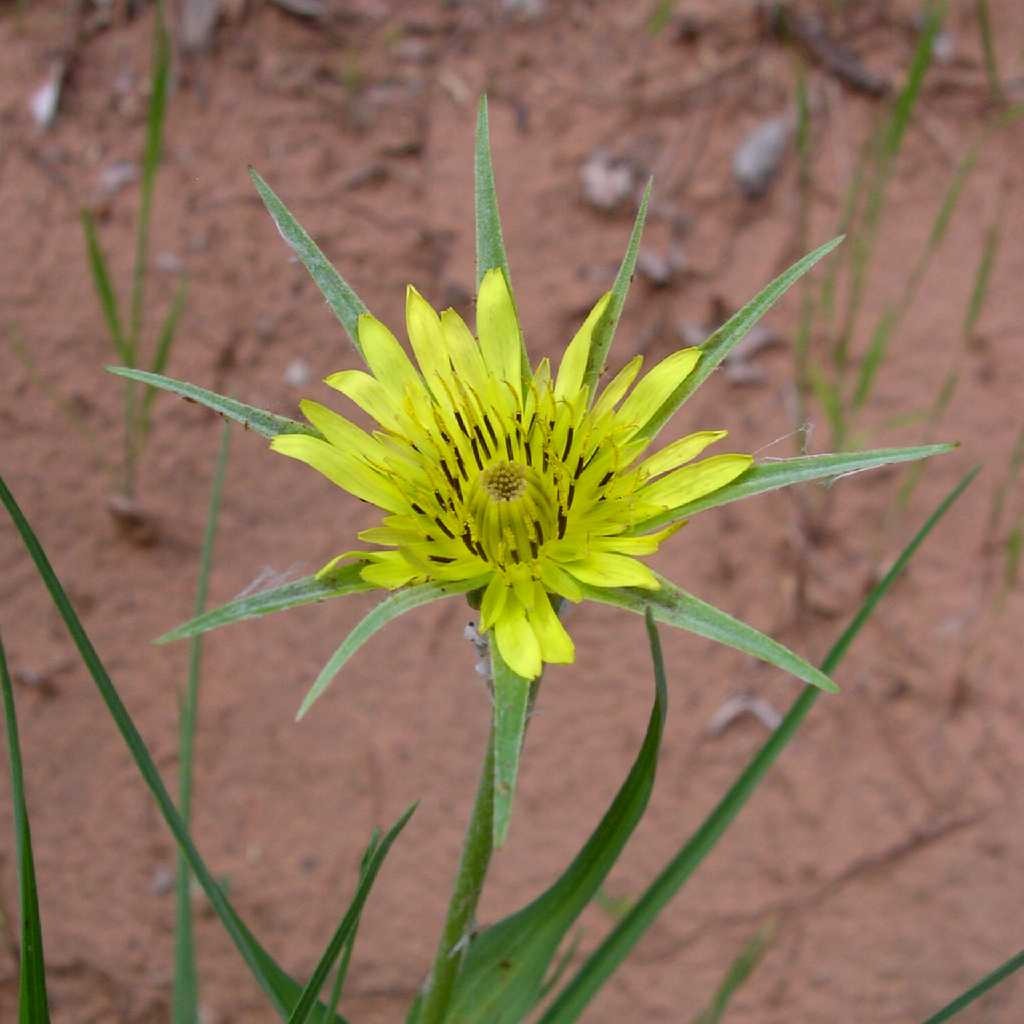
Goat’s Beard, also known as Yellow Salsify, features large, dandelion-like yellow flowers that open in the morning and close by midday. The plant has grass-like, narrow leaves and grows up to 3 feet tall. Its most recognizable feature is the large, globe-shaped seed head resembling that of a dandelion but much larger.
It prefers dry, open habitats including prairies, roadsides, and vacant lots. Goat’s Beard is a biennial plant, forming a basal rosette in the first year and flowering in the second. It reproduces exclusively by seed, which is dispersed by wind thanks to the fluffy pappus attached to each seed.
Originally from Europe and western Asia, Goat’s Beard is now widespread in the United States and Canada, particularly in USDA zones 3 to 9. While occasionally appreciated for its striking seed heads, it is often considered a nuisance in unmanaged areas.
Sow Thistle (Sonchus oleraceus)

Common Sow Thistle is an annual or biennial weed with erect, hollow stems and spiny, lobed leaves that clasp the stem in a distinctively winged fashion. The bright yellow flowers resemble those of a dandelion and bloom throughout much of the growing season. When broken, the plant exudes a white, milky sap.
It is typically found in gardens, fields, roadsides, and waste areas, often thriving in nutrient-rich, disturbed soils. Sow Thistle grows quickly and competes aggressively with nearby vegetation. It can reach heights of 2 to 5 feet and spreads through wind-dispersed seeds that germinate readily in moist soil.
Native to Europe and Asia, Sow Thistle is now widely distributed across North America in USDA zones 4 to 10. While young leaves are edible and used in some cuisines, the plant is generally considered a weedy invader due to its persistence and fast growth.
Common Tansy (Tanacetum vulgare)
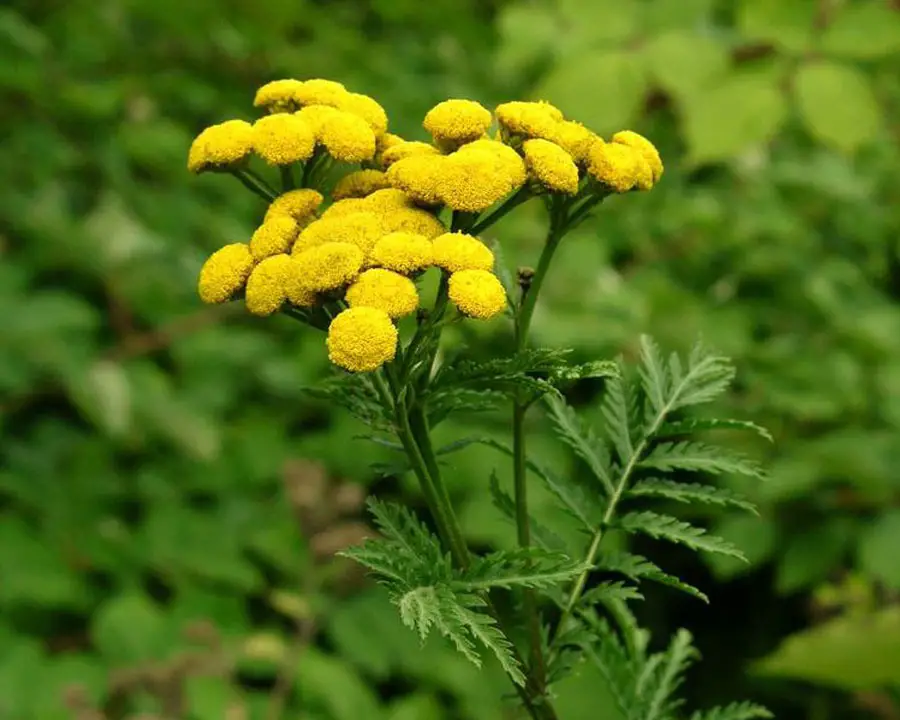
Common Tansy is a tall, aromatic perennial with clusters of button-shaped, golden-yellow flowers that appear in midsummer. The leaves are fern-like, deeply divided, and emit a strong, camphor-like scent when crushed. The plant can grow up to 5 feet tall and often forms dense colonies through underground rhizomes.
It is commonly found in roadsides, fields, riverbanks, and disturbed areas. Tansy prefers well-drained soil and full sun but can tolerate a range of conditions. Its pungent odor and bitter taste make it unpalatable to most grazing animals, allowing it to spread easily where competition is low.
Native to Europe and Asia, Common Tansy has naturalized across much of North America and is hardy in USDA zones 3 to 9. While it was historically used as a medicinal and insect-repelling herb, it is now considered invasive in many areas due to its aggressive spreading and displacement of native species.
Perennial Sow Thistle (Sonchus arvensis)
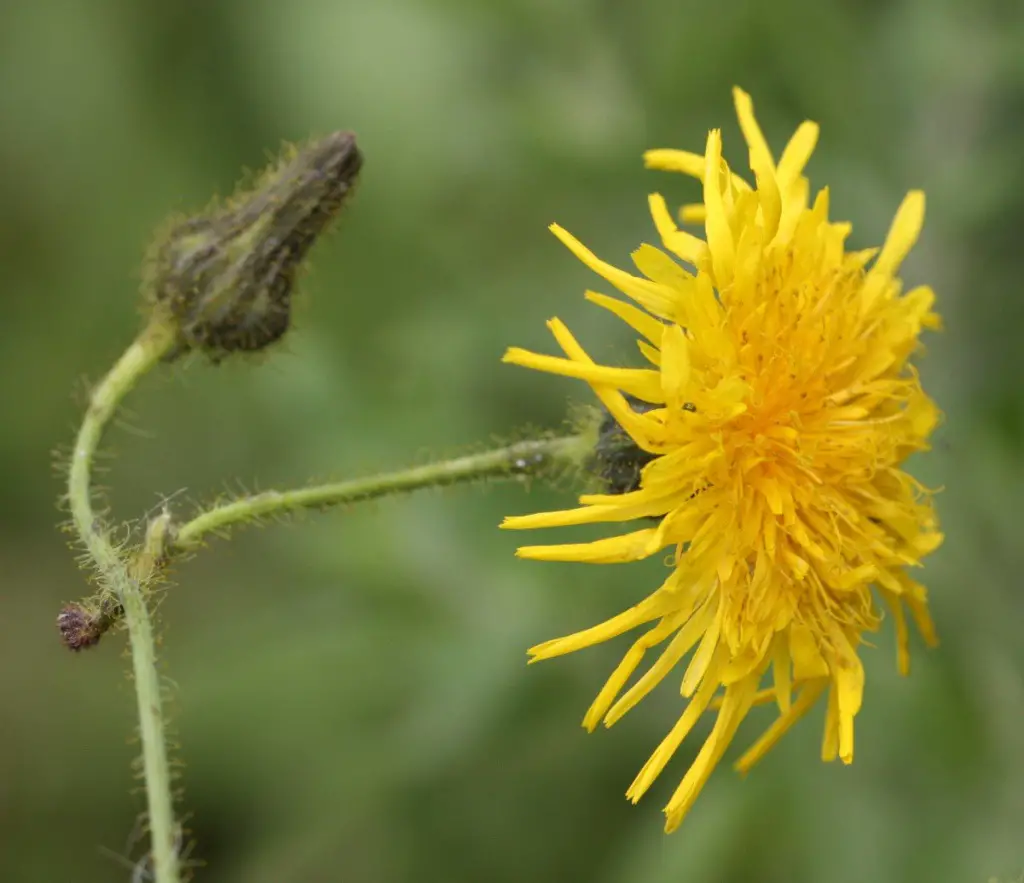
Perennial Sow Thistle resembles its annual cousin but is more vigorous, with thicker stems and a height that can exceed 5 feet. It produces yellow, dandelion-like flowers on branching stems, and its leaves are spiny, lobed, and clasp the stem. The plant exudes a milky latex when broken, which is typical of members in the Asteraceae family.
This perennial weed is especially invasive due to its deep, spreading rhizome system, which enables it to colonize large areas quickly. It thrives in disturbed sites, pastures, roadsides, and croplands, often forming dense stands that outcompete native vegetation. It blooms from summer into fall, reproducing through both seeds and creeping underground stems.
Originally native to Europe and western Asia, Perennial Sow Thistle is now found throughout much of North America and is hardy in USDA zones 3 to 9. Its persistence, adaptability, and aggressive growth make it a problematic weed in both agricultural and natural settings.
Golden Clover (Trifolium aureum)
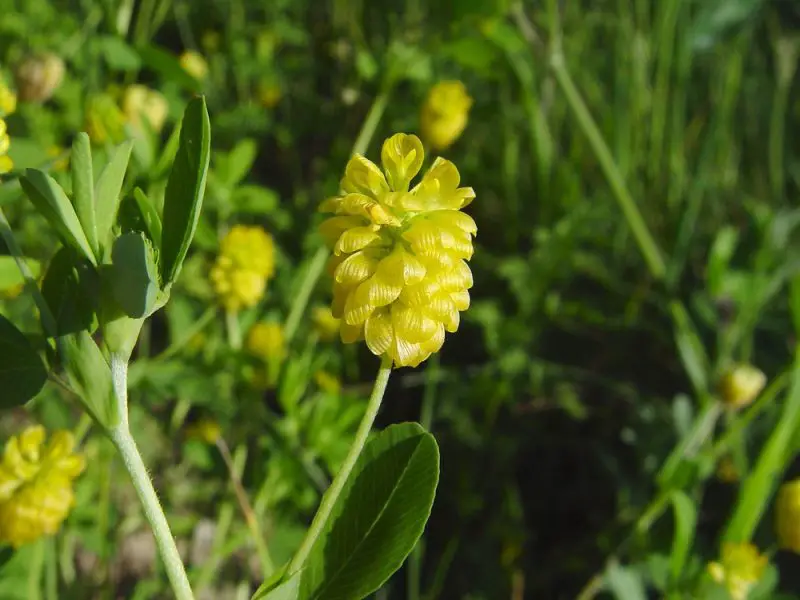
Golden Clover is a short-lived perennial or biennial that grows between 1 and 2 feet tall. It features trifoliate leaves typical of clovers and produces dense, round flower heads made up of small, golden-yellow flowers. The stems are erect and hairy, giving the plant a somewhat weedy appearance.
This plant is often found in dry meadows, roadsides, and waste areas where the soil is poor but well-drained. It tolerates full sun and is drought-resistant, often colonizing disturbed or low-maintenance land. Golden Clover typically blooms in late spring and early summer, attracting bees and other pollinators.
Native to Europe and Asia, Golden Clover has become naturalized in parts of North America, especially in USDA zones 3 to 8. While not as aggressive as some invasive weeds, it can become weedy under the right conditions and is often considered a minor pest in pastures and lawns.
Yellow Pimpernel (Lysimachia nemorum)
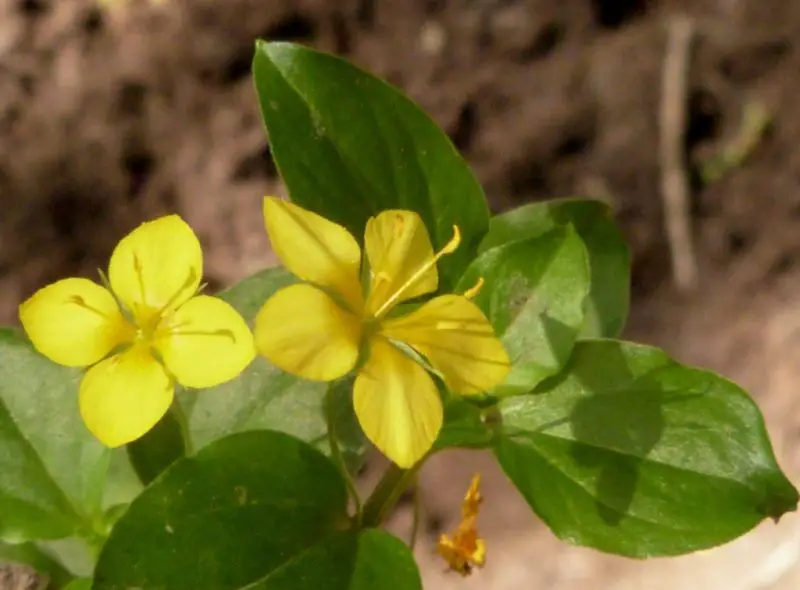
Yellow Pimpernel is a delicate, low-growing perennial herb with small, star-shaped yellow flowers that bloom in late spring and early summer. The flowers have five pointed petals and are borne singly on slender stalks above smooth, ovate green leaves. It typically grows no more than 12 inches in height.
This species thrives in moist, shady environments, such as forest edges, damp meadows, and stream banks. It prefers humus-rich, slightly acidic soils and spreads gently by creeping stems, forming a low carpet of green foliage and yellow blooms.
Native to Europe, Yellow Pimpernel is occasionally found in North America and is hardy in USDA zones 5 to 8. While not an aggressive weed, it may spread in suitable woodland gardens or moist, shaded areas where competition is low.
Hoary Alyssum (Berteroa incana)
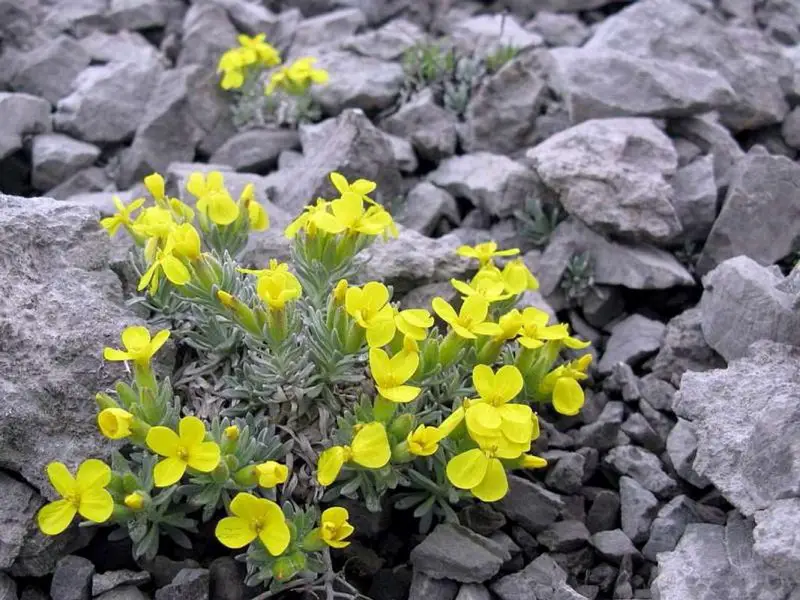
Hoary Alyssum is a toxic weed with small, pale yellow to white flowers arranged in loose clusters. The leaves and stems are covered in dense, grayish hairs, giving the plant a silvery appearance. It typically grows 1 to 3 feet tall and has a stiff, upright growth habit.
This plant is most commonly found in dry, gravelly soils, along roadsides, in pastures, and in disturbed sites. It blooms from early summer through fall and is especially dangerous in hayfields, as ingestion by horses can lead to lameness, fever, and other health issues. It spreads by seed and is very drought-tolerant.
Native to Eurasia, Hoary Alyssum is now naturalized across parts of North America, particularly in USDA zones 3 to 9. It is considered an invasive weed in some areas due to its adaptability, toxic effects on livestock, and ability to colonize poor soils quickly.
Prickly Lettuce (Lactuca serriola)

Prickly Lettuce is a tall, upright annual or biennial weed that can reach heights of up to 6 feet. It features deeply lobed leaves with bristly spines along the leaf margins and undersides of the midrib. The yellow flowers are small and dandelion-like, clustered at the top of the plant and bloom from midsummer to fall.
It commonly grows in disturbed areas such as roadsides, gardens, and vacant lots. This weed prefers full sun and tolerates dry soils, making it a common sight during hot, dry summers. It produces a white latex when cut and releases numerous wind-dispersed seeds.
Native to Europe and parts of Asia, Prickly Lettuce is now widespread across North America and grows well in USDA zones 4 to 9. Though not typically harmful, it competes aggressively with crops and garden plants and is considered a nuisance in agricultural and urban environments.
Wild Parsnip (Pastinaca sativa)
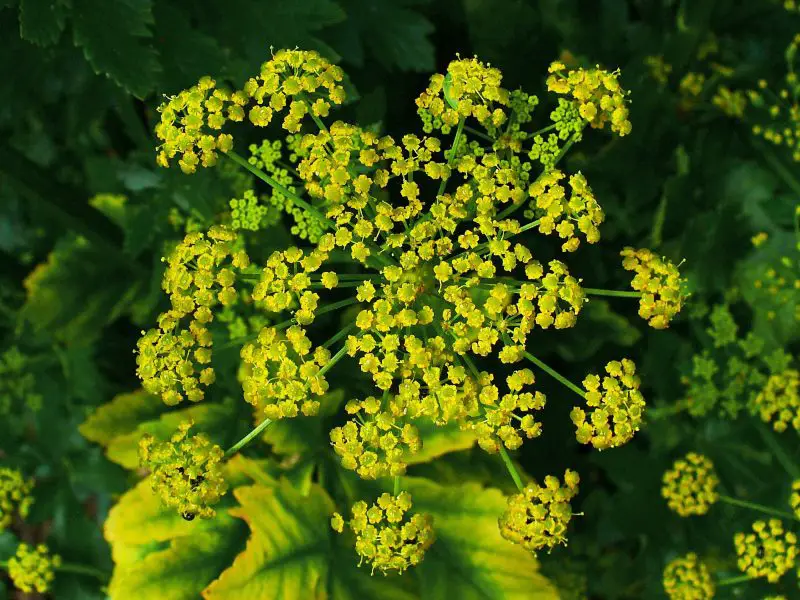
Wild Parsnip is a tall biennial or perennial plant that can reach heights of up to 5 feet. Its large, yellow flower clusters resemble umbrella-like umbels, typically appearing in midsummer. The plant’s leaves are deeply divided, resembling those of celery, and have a rough texture. When the plant blooms, it produces an array of small, yellow flowers arranged in large clusters at the top of the stalk.
This plant is native to Europe and Asia but has become invasive in North America. Wild Parsnip grows in disturbed areas such as roadsides, fields, and waste areas, often thriving in poor soils. Its sap can be highly irritating to human skin and, when exposed to sunlight, can cause severe burns and blisters, a condition known as phytophotodermatitis.
Wild Parsnip is hardy in USDA zones 3 to 8. While it may add a unique look to wildflower meadows, its toxicity and aggressive growth make it a hazardous weed, particularly in areas where it displaces native vegetation and poses a risk to those who come into contact with it.
Yellow Nutsedge (Cyperus esculentus)
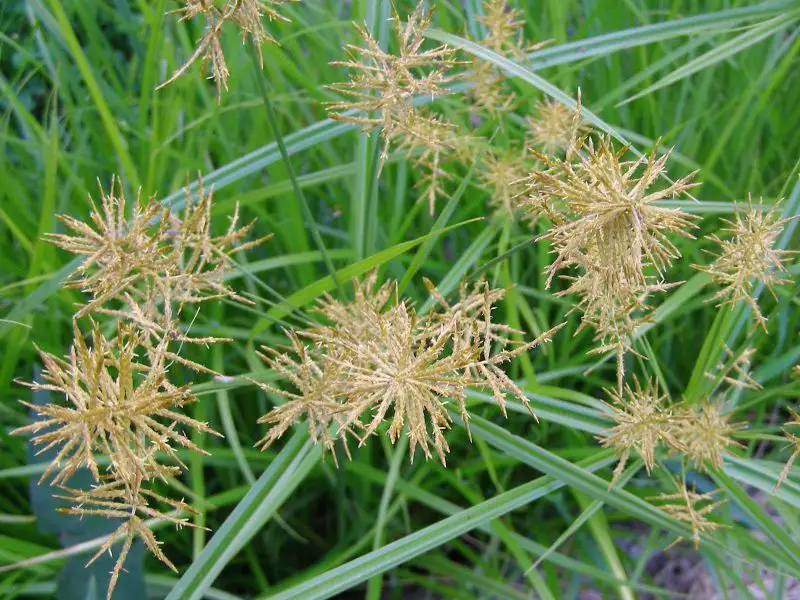
Yellow Nutsedge, a perennial weed, is grass-like but distinguished by its triangular stems and yellowish flower spikes that appear in late summer. It grows in dense clumps and features long, slender, green leaves that resemble those of grass but have a sharper texture. The flowers are small and arranged in spikelets at the top of the plant, forming a branched, umbrella-like shape.
This weed thrives in wet, poorly-drained soils and is commonly found in fields, lawns, gardens, and wet ditches. Unlike grasses, Yellow Nutsedge spreads both through seed and underground tubers, which can remain dormant in the soil for several years. Its presence can be particularly problematic in crops like vegetables and turfgrass due to its rapid spread.
Native to Eurasia, Yellow Nutsedge has become widespread across North America, particularly in USDA zones 4 to 9. Its aggressive growth habit, resistance to many herbicides, and ability to regenerate from tubers make it a persistent weed in agricultural and landscaped areas.
Golden Groundsel (Packera aurea)

Golden Groundsel is a low-growing, perennial herb that spreads rapidly and produces bright yellow daisy-like flowers in early spring. The flowers are clustered in small, flat-topped heads, while the plant itself has smooth, rounded leaves that form a rosette at the base. It typically grows to a height of 12 to 18 inches and can cover large areas when allowed to spread unchecked.
This plant is commonly found in moist, shaded areas such as stream banks, forests, and wetlands. Golden Groundsel prefers partial to full shade and moist, well-drained soil. It tends to bloom early in the spring, providing an early nectar source for pollinators, and continues to spread via both seeds and rhizomes.
Native to North America, Golden Groundsel is hardy in USDA zones 4 to 9. While it is not typically harmful, its ability to spread quickly makes it a competitive plant in naturalized areas, potentially crowding out other native species.
Common Fleabane (Erigeron philadelphicus)
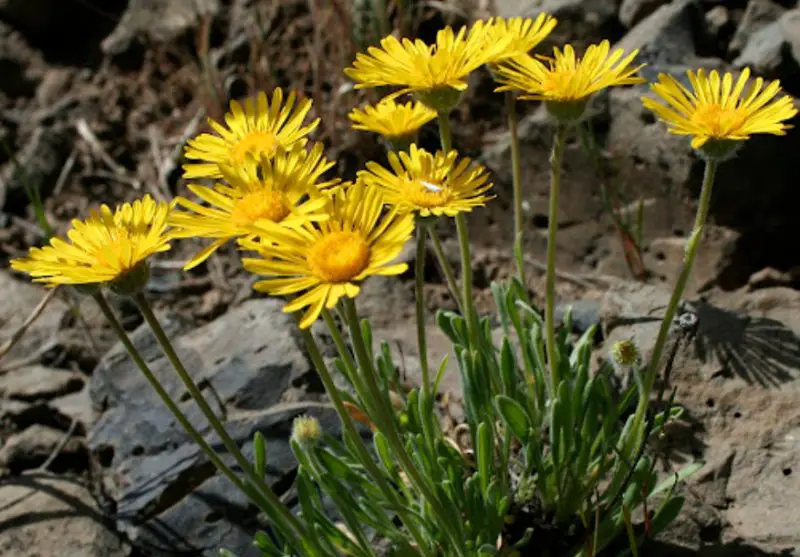
Common Fleabane is a perennial plant that can reach up to 3 feet in height, with multiple branched stems that bear small, daisy-like flowers. The flowers are characterized by a yellow disc center surrounded by thin, white or pale yellow ray florets. In some weedy forms, the ray petals may be absent, making the entire flower appear yellow. The plant’s leaves are lance-shaped and slightly hairy, with a rough texture.
This plant is highly adaptable and thrives in a variety of environments, including roadsides, fields, meadows, and disturbed soils. Common Fleabane blooms in late spring to early summer and is often found in areas with high sun exposure. It is known for its ability to spread quickly through seed production, which is dispersed by the wind.
Native to North America, Common Fleabane is hardy in USDA zones 4 to 8. While its bright yellow flowers may be attractive in wildflower gardens, its rapid growth and tendency to reseed make it a challenging weed in some areas, particularly where it outcompetes other species.
Yellow Corydalis (Corydalis lutea)
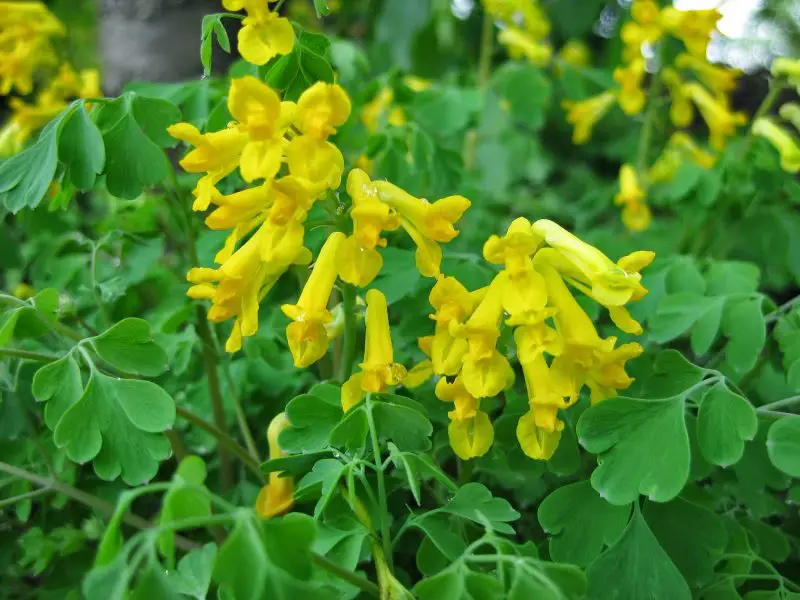
Yellow Corydalis is a perennial plant with delicate, tubular yellow flowers that bloom in early to mid-spring. The flowers are arranged in clusters and appear on arching stems that rise above the feathery, fern-like leaves. This plant has a low, spreading habit and typically grows between 6 to 12 inches in height, making it a perfect ground cover in shaded or woodland settings.
This shade-loving weed is often found in moist, well-drained soils in woodland areas, shaded hillsides, or along stream banks. It prefers areas with light to full shade, where its soft yellow flowers can brighten up the landscape. Yellow Corydalis can spread through both seeds and underground rhizomes, forming dense patches in suitable environments.
Native to Europe, Yellow Corydalis is now widely distributed in North America and is hardy in USDA zones 4 to 9. Although it is not typically harmful, its ability to spread and naturalize in shaded, damp habitats makes it a potential nuisance in garden beds and woodland areas.
Yellow Salsify (Tragopogon pratensis)
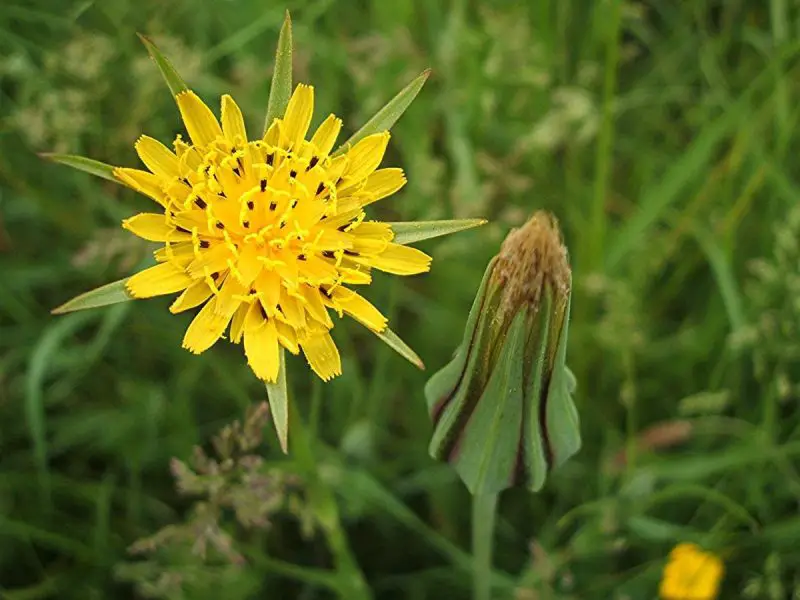
Yellow Salsify is a tall, slender biennial weed with bright yellow, daisy-like flowers that resemble dandelions. Its flower heads are larger than those of common dandelions and open early in the morning, closing by midday—a trait that earned it the nickname “Jack-go-to-bed-at-noon.” The plant produces long, narrow leaves that taper at the base and a single upright stem.
Yellow Salsify is commonly found in meadows, roadsides, and disturbed soils, especially in areas with full sun and well-drained conditions. It blooms from late spring to early summer and is often identified by its large, spherical seed heads, which resemble oversized dandelion puffballs. The seeds are dispersed by wind, allowing the plant to colonize new areas rapidly.
Native to Europe and Asia, Yellow Salsify is widely naturalized across North America and is hardy in USDA zones 3 to 9. While it can be an attractive wildflower, its tendency to spread quickly makes it a persistent weed in pastures and roadside environments.
Common Evening Primrose (Oenothera biennis)
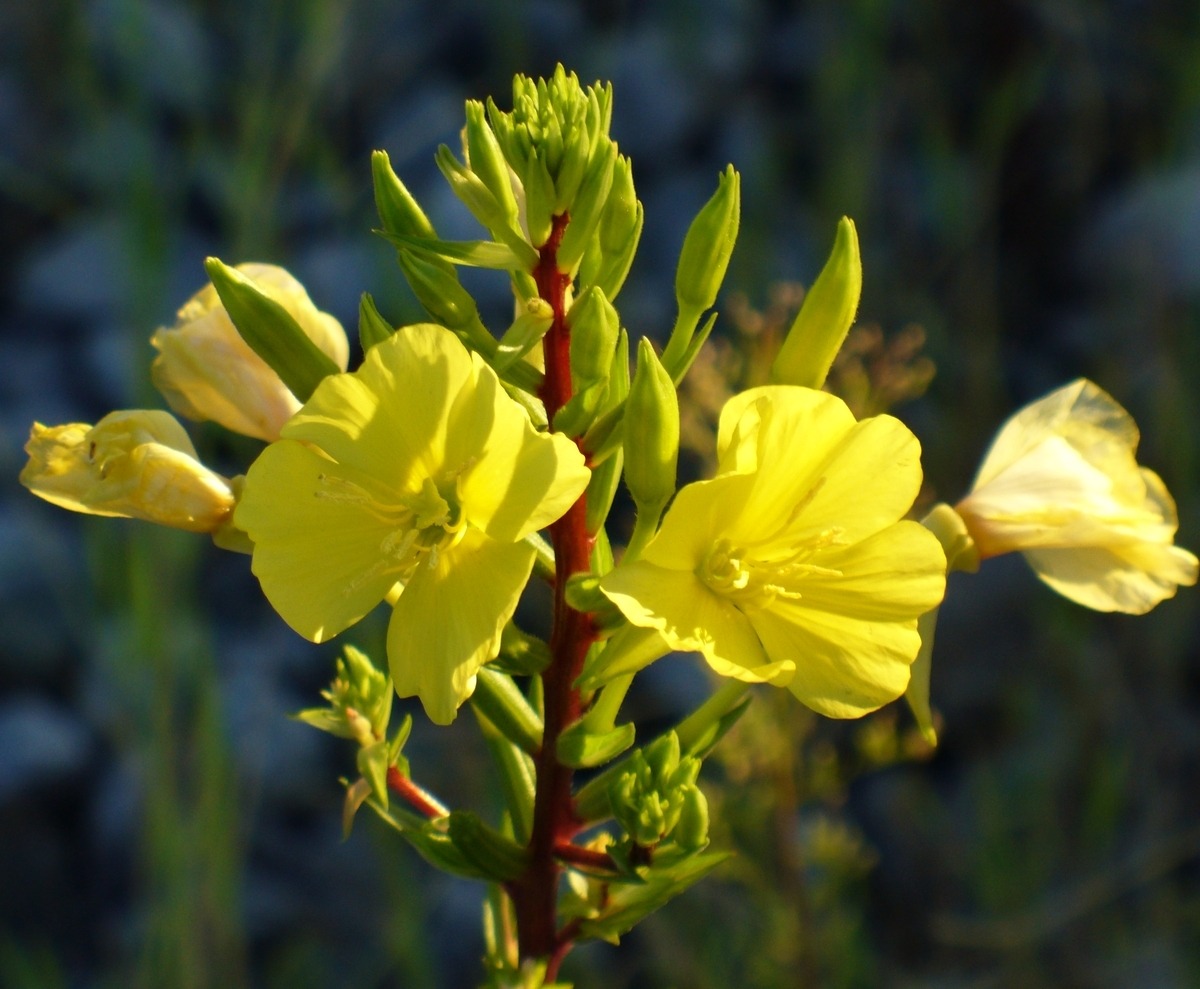
Common Evening Primrose is a biennial plant that can grow up to 6 feet tall, producing clusters of four-petaled yellow flowers that open in the late afternoon or evening. The blossoms are fragrant and typically bloom from late spring through summer. The plant forms a basal rosette of lance-shaped leaves in its first year, followed by a tall flowering stalk in its second.
This species prefers open, sunny environments and is commonly found in disturbed soils, prairies, fields, and roadsides. Evening primrose is known for its ability to thrive in poor, dry soils, making it a frequent colonizer of marginal lands. Its flowers attract nighttime pollinators like moths and are often visited by bees in the early morning before they close.
Native to North America, Common Evening Primrose is hardy in USDA zones 4 to 9. Though sometimes cultivated for its oil or wildflower appeal, it can become weedy in unmanaged areas due to its prolific seed production.
Golden Pea (Thermopsis divaricarpa)
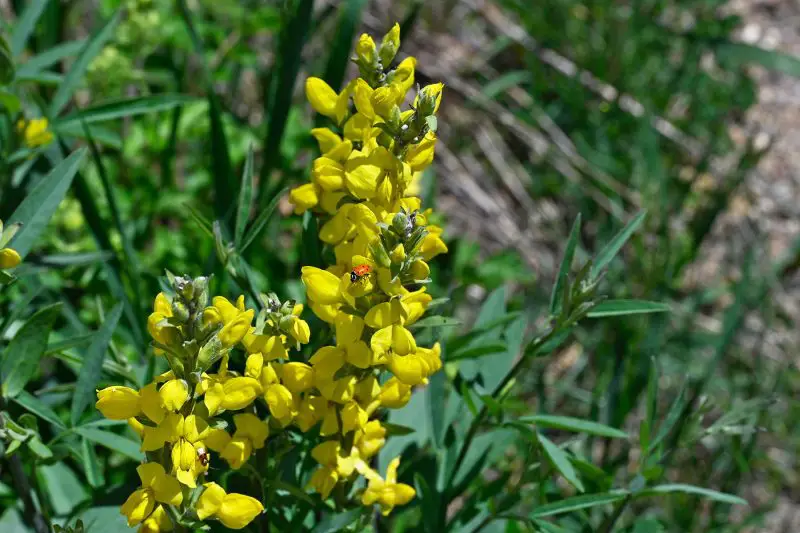
Golden Pea is a perennial member of the legume family, producing bright yellow, pea-like flowers on upright stems. The flowers bloom in clusters during late spring to early summer and are accompanied by compound leaves composed of three leaflets. The plant can reach up to 3 feet in height and often forms small colonies.
This hardy species is found in dry meadows, open woodlands, and roadsides, particularly in western and central North America. Golden Pea thrives in full sun and well-drained soils and is drought-tolerant once established. It is especially common in disturbed areas and can spread through both seed and underground rhizomes.
Golden Pea is suited to USDA zones 4 to 8. While it is visually appealing and used in some restoration projects, its spreading habit and ability to colonize open ground rapidly make it a potential weed in natural landscapes and gardens.
Yellow Archangel (Lamium galeobdolon)
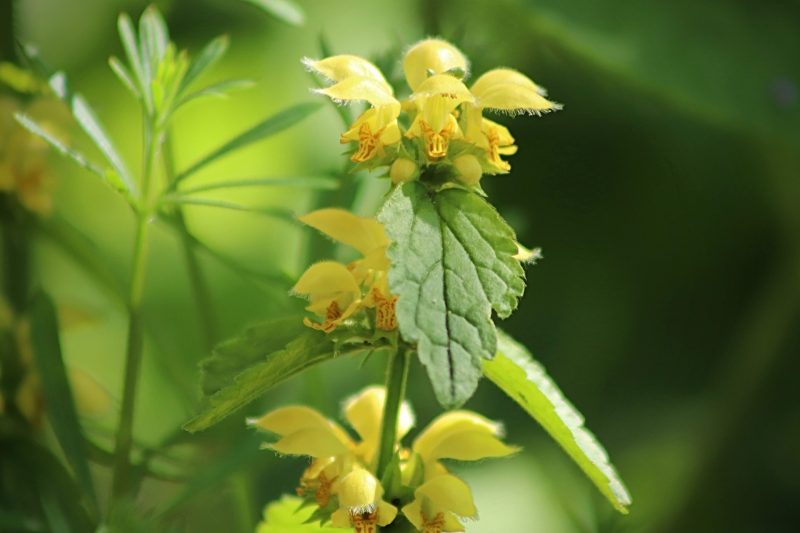
Yellow Archangel is a fast-spreading groundcover with distinctive yellow, hooded flowers that bloom in whorls along square stems. The plant features variegated, silvery-green foliage with toothed edges, making it easy to distinguish from native groundcovers. It typically grows 8 to 12 inches tall and spreads aggressively by runners.
This plant thrives in shady to partially shaded environments and moist, fertile soils, often escaping from gardens into adjacent woodlands. It blooms from late spring through early summer and can form dense mats that outcompete native plants, especially in forest understories and riparian zones.
Native to Europe and western Asia, Yellow Archangel is hardy in USDA zones 4 to 9. Though it is sometimes used in ornamental landscapes, it is considered invasive in many regions due to its vigorous spreading habit and ability to dominate ground layers in woodland ecosystems.
Yellow Hawkweed (Hieracium caespitosum)

Yellow Hawkweed is a perennial plant that forms low-growing rosettes of hairy, lance-shaped leaves. In late spring to early summer, it sends up leafless stems topped with clusters of bright yellow, dandelion-like flowers. Each stem may bear several flower heads, and the entire plant is covered with fine hairs.
This weed prefers sunny, well-drained habitats such as pastures, meadows, and roadsides. It spreads aggressively through both wind-dispersed seeds and stolons (above-ground runners), forming dense mats that crowd out native vegetation. Its ability to thrive in poor soils makes it a common sight in disturbed areas and degraded grasslands.
Native to Europe, Yellow Hawkweed has become invasive in many parts of North America and is hardy in USDA zones 3 to 9. Though its bright flowers may appear ornamental, it is a persistent and difficult-to-control weed in both agricultural and natural landscapes.
St. Barnaby’s Thistle (Centaurea solstitialis)
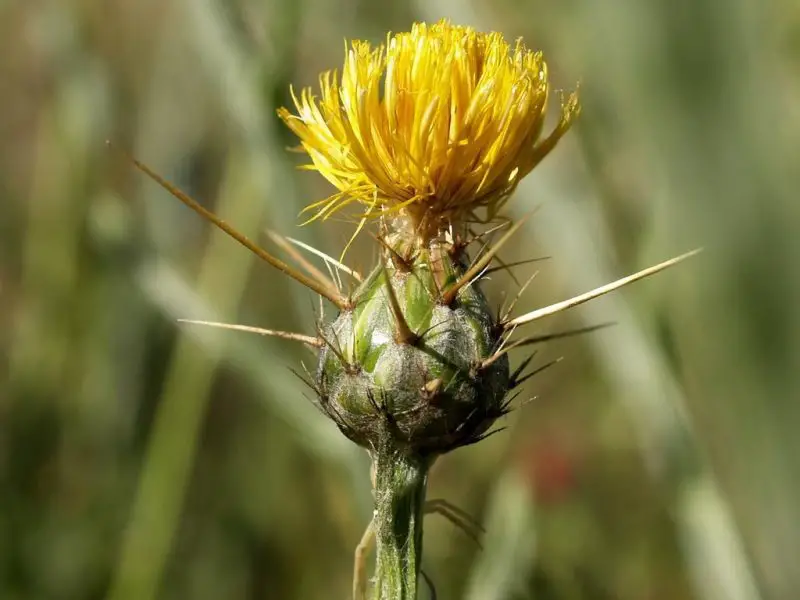
St. Barnaby’s Thistle, also known as Yellow Star Thistle, is a highly invasive plant recognized by its spiny, thistle-like yellow flower heads. Each flower is surrounded by sharp, straw-colored spines that radiate outward, resembling a star. The stems are stiff and branched, often covered with fine white hairs, and the narrow leaves are deeply lobed.
This weed thrives in dry, disturbed soils and sunny open habitats, such as roadsides, rangelands, and abandoned fields. It is particularly aggressive in areas with Mediterranean climates and tends to dominate landscapes by forming dense monocultures. It flowers from late spring through summer and reproduces exclusively by seed.
Native to Eurasia, St. Barnaby’s Thistle is invasive across much of the western United States and is considered a noxious weed in several states. It is hardy in USDA zones 4 to 9. Its deep taproot allows it to outcompete native grasses and forbs, and its spiny flower heads deter grazing, making it problematic for livestock management.
Yellow Water Iris (Iris pseudacorus)
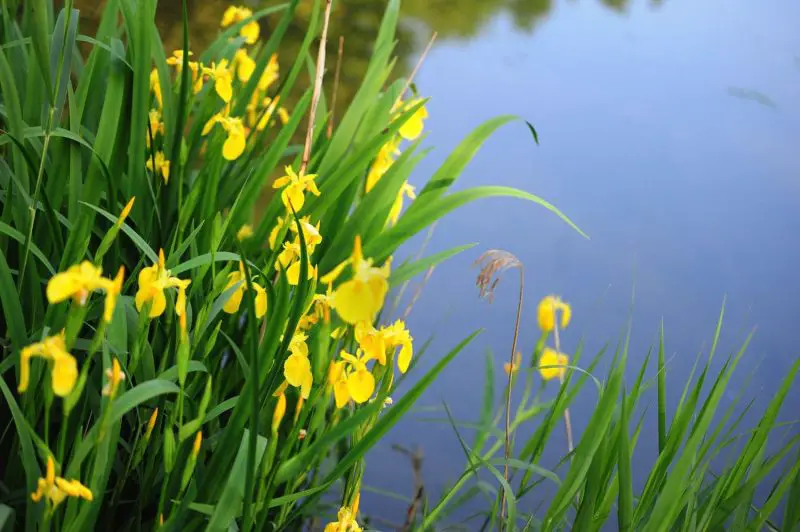
Yellow Water Iris is a striking aquatic perennial that produces large, showy yellow flowers with three prominent downward-curving petals. The sword-shaped leaves are long, flat, and upright, resembling those of other iris species. It typically grows 3 to 5 feet tall and forms dense clumps along shorelines and in shallow water.
This species thrives in wetlands, marshes, pond edges, and ditches, where it can tolerate standing water and seasonal flooding. It spreads aggressively by rhizomes and can also propagate through waterborne seeds, quickly forming dense mats that displace native wetland vegetation. Blooming typically occurs in late spring to early summer.
Native to Europe, North Africa, and western Asia, Yellow Water Iris is hardy in USDA zones 4 to 9. Though once used in ornamental water gardens and for erosion control, it is now recognized as a serious invasive species in many North American wetlands due to its environmental impact and rapid spread.
Yellow Flax (Linum flavum)
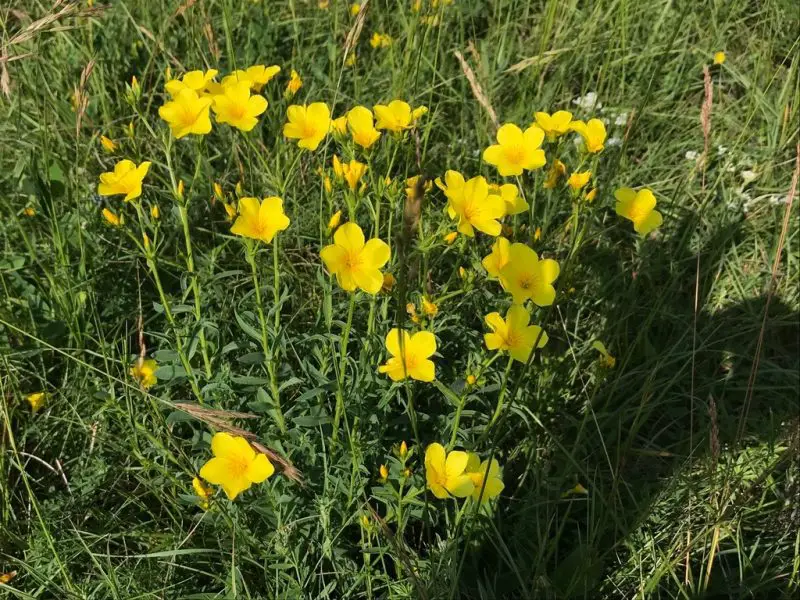
Yellow Flax is a graceful, herbaceous perennial that produces delicate yellow, five-petaled flowers on wiry stems. The flowers bloom in clusters and open during sunny parts of the day. The foliage is narrow, linear, and slightly bluish-green, adding to the plant’s airy and fine-textured appearance.
Often introduced to gardens for its ornamental value, Yellow Flax can escape cultivation and establish itself in meadows, dry slopes, and disturbed sites. It prefers full sun and well-drained, sandy or rocky soils. Blooming occurs from late spring through summer, and the plant is especially attractive to pollinators such as bees and butterflies.
Native to central and southern Europe, Yellow Flax is hardy in USDA zones 5 to 9. While not as aggressively invasive as some other species, its ability to naturalize and spread in favorable conditions has led to occasional concerns in native grasslands and prairie restoration zones.


